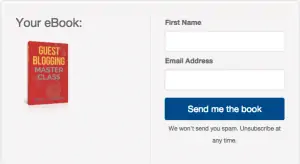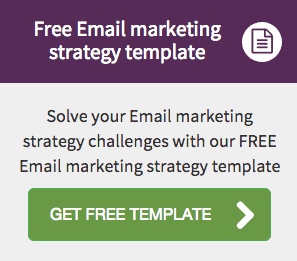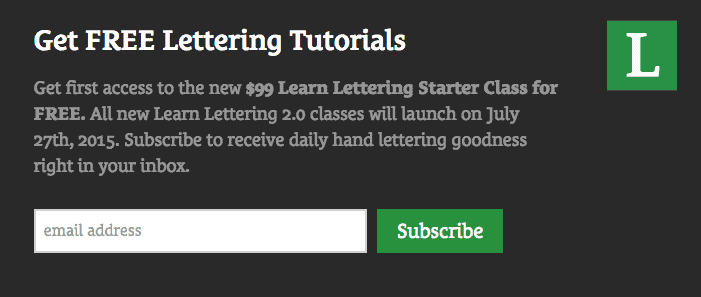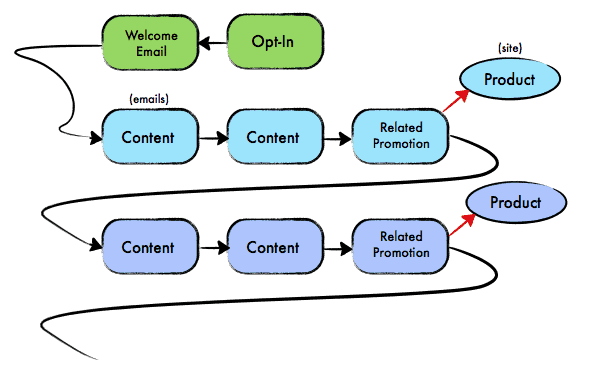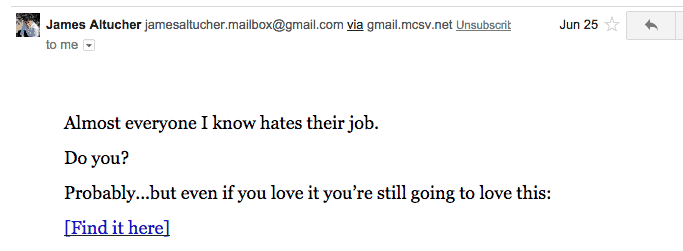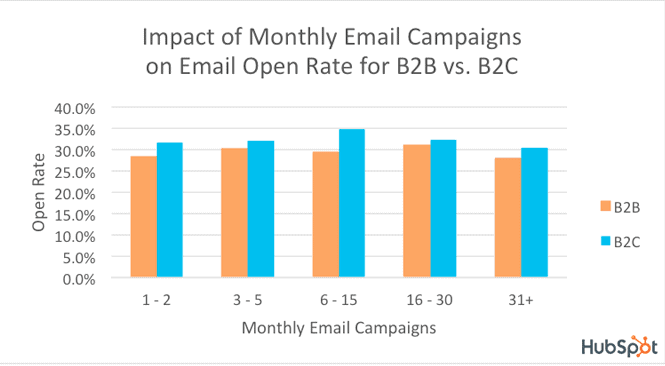9 out of 10 people check their email at least once a day. This means that every email you send to your customers is likely to be seen, and on the same day.
Despite the resounding evidence, for the first two years of my business, I wasn’t using email marketing. I wish I had a good excuse for why, but I don’t.
Instead, I was focused on creating more and more content. Meanwhile I was ignoring one of the most important aspects of online business.
Fortunately that’s all changed. Now I’ve implemented email autoresponders that automatically send new subscribers a series of emails providing them with content and providing me with sales. The below post covers my best advice for capturing new email subscribers and sending them emails. At the end I will link you to the Google Doc with my entire autoresponder strategy laid out including every email I will be sending to my list.
Why are email autoresponders so effective?
Getting traffic is hard and expensive. Converting them to paying customers is even harder and more expensive.
So how can you make converting subscribers into paying customers easier and cheaper? And how can you increase my customer lifetime value even further once I do?
Prior to capturing email addresses, the lifetime value of one of my visitors was pretty low. They come to my site, maybe the buy a book or two, and then never again do they give me money, or come back to my site, and never again am I able to provide them significant value.
Generating traffic without email marketing is like filling a leaky bucket with water. Not exactly a great business model.
More recently, I’ve learned from my mistakes and focused more and more on building my email list. And it’s going pretty well.
It’s bittersweet, though. See, because it’s been so successful recently, I’m kicking myself for being blind to this huge opportunity for the last two years.
The Missing Piece
But, there’s one aspect of email marketing I’ve still been putting off for a while now: creating an email autoresponder.
I’ve learned that autoresponders can help me increase my customer lifetime value even more. As you’ll see, I’ve realized that I’ve been leaving a lot of money on the table.
Take one second and imagine you’ve just finished your first ecourse and you can’t wait to promote it.
You do a few guest posts, send it to your email list, share it on social media, and end up making a few thousand dollars on the launch.
But, three weeks later, the course loses it’s momentum and you don’t get any more sales.
You create a second course and repeat the process. Then, a third.
But you start to see the same pattern, customers are only buying one of your products and every time you create a new course, you only make money during the launch.
You can’t seem to figure out how to keep the momentum going, and it seems like too much work to keep launching new products.
It turns out that creating an autoresponder solves these problems and is not that hard to implement.
Imagine that same scenario, but instead of worrying about launching and promotion, it’s all automated.
This time, anyone who opts in to your email list goes into a series of emails that sends them promotions to all of your courses over time, leading to more sales. All of this taking place whether you are awake or not.
This enables you to increase your customer lifetime value without doing any extra work once you set it up.
That doesn’t sound so bad, does it?
Refill your espresso and get ready, because this post is going to hit you with everything you need to know about how to create an email autoresponder.
What exactly are autoresponders?
Autoresponders are emails sent automatically to anyone who subscribes to your email list.
Autoresponders allow you to turn new leads into paying customers 24/7, 365, while you’re smoking cuban a cigar and sipping a gin and tonic in the Thai Islands. Wouldn’t it be awesome to get more traffic and increase your customer lifetime value…all on autopilot?
For example, when people first sign up for your newsletter, you can set up an autoresponder to send people a welcome email. Then, a few days later, you can send them another email with a few links to blog posts, an invitation to follow your business on social media, and other valuable content. Then, the next week, you send them another email selling something, and so on.
The best part? It’s automated.
Who Should Use Autoresponders?
I feel like a hypocrite on this one since I’ve gone so long without one. But, the more I learned about autoresponders, the more I realized how important it was for 99% of businesses. I even hired help to get it done ASAP. (Learn more about exactly what I’ll be doing at the end of the post.) The real question is, “who shouldn’t be using an autoresponder?!”
Are you a blogger that’s selling a product? Are you a b2b company using lead nurturing to get sales? Research shows that autoresponders can increase sales dramatically.
Or, Maybe You’re Facing One of the Following Business Problems:
– You’re leaving money on the table by not following up with old customers with upsells and cross-promotions
-Customers are abandoning their carts on your mobile site while shopping for your product
-You’re getting quality leads when they sign up for a webinar or a free Ebook, but you’re not converting them into paid customers
-You don’t know much about your leads and you want to better meet their needs with content or your product/services
-You have leads that go quiet for several months and don’t continue moving through the sales funnel
An effective autoresponder is a great solution to all of these problems.
The only way an autoresponder sequence can hurt you is if you have a horrible email campaign set in place (we’ll get to how to avoid that later on).
Get More Engagement Without Engaging
If you’re like me, you’ve got a ton of content on your site, some of which you are more proud of than others.
When people are on your site, you don’t have much control over which articles they will click. Maybe you’ve got one or two epic posts that everyone loves that you want people to see because it leads to sales.
I know I personally have a few blog posts that everyone seems to love, but they don’t get the views they deserve simply because they’re in the back in the stack on my blog.
But when you’re sending them emails, you can make sure visitors see your high value content: blog posts, white papers, training videos, etc, in whatever order you want!
Oh, and you can do this forever. Just like 7/11, your email-autoresponder NEVER CLOSES. 24/7. 365. Sounds like a lazy marketer’s dream!
You can also engage in one-on-one conversations with customers through email, simply by getting them to hit ‘reply’ to an email. Engaging with customers is great, as you can get feedback and start a conversation that can lead to a sale.
Lastly, it makes you more money and increases conversions. A successful autoresponder can triple or even quadruple your sales. In a study done by Capterra, results showed that the average return on $1 spent on email marketing is $44.25. That’s 4,425% ROI.
How to Capture Email Subscribers
Hopefully, by now you’ve already been capturing emails and building your email list. Before you can start sending autoresponders, you of course need to have email addresses to send them to.
There are several methods to do this, but one of the most effective way to capture emails is by offering a bribe. I don’t mean bribe as in corrupt governments, I just mean you need to provide value in exchange for their email.
What makes a good bribe? It generally depends on your audience and how they found your site, but here are some possible options:
-A Welcome E-series: This is a few friendly emails that welcomes them and prepares them for the valuable content that you are able to offer them. The goal is to keep the readers engaged from the get go, and to keep them engaged by continuing to send them value and perhaps offers to your products.
Instead of having them wait for your next blog post or email to come out, you can put the emails on autopilot so the reader receives your emails at any frequency you decide on.
– An ebook: I sell many books on Amazon, but recently, I’ve been giving shorter versions away for free as an email opt-in. Sure, I may be losing money in the short term, but I’m providing value, earning trust, and keeping them on my email list in the long term.
For example, one give away is an book on guest blogging (see image below). But, if they read and enjoy that book, I have plenty of other books to offer them as upsells.
-A Timesaving Cheat Sheet: Think of this as a secret formula to help your readers become more productive or quickly accelerate their skills. This needs to save the reader time and effort.
-A Useful Template: Do you have a framework for success that you can share with others?
Some examples include a template for: writing proposals, coming up with blog post ideas, cold e-mailing, crafting cover letters, coming up with business ideas, etc.
(Screenshot from smartinsights.com/email-marketing)
-A Fascinating Case Study: If you enjoy storytelling, giving an epic case study is an effective and creative way to capture emails. Don’t just give away the tips and takeaways, though. Walk them through the story and take them on an adventure.
Include the mistakes you made and lessons you learned. Talk about the challenge at hand, and be inspirational. This is a great way to remind your readers that they’re just as capable of being successful as you are. Just make sure you have sufficient interviews and other supplementary materials as well as a great story to tell.
-A Free Training Series: This is similar to a welcome series, but instead of welcoming them, you’re teaching them something. A training series can be as short or long as you want, as long as you are providing them value.
Some examples: “4-part series of how to get higher paying clients”, “how to productize your service”, and “training series how to create a blog that converts”.
(From Seanwes.com)
-A Video Course: If you’ve got the personality and don’t mind getting on camera, then there’s no better way to provide value and establish a connection with your audience than through video.
This can be one video or many. If you already sell a video course as a product, giving away the first few videos for free (in exchange for their email) is a great strategy.
What To Include In Your Autoresponder Emails
So, you’ve captured a potential customer’s email by offering some sort of bribe, but you don’t want to send them the bribe and then go silent. Your autoresponder should go beyond just the bribe. Remember, your ultimate goal is to sell, upsell, or cross-sell.
There are several different approaches you can take in your autoresponder. Each depends on your business, brand, product, etc. So, first things first, you need a goal. If you’re not sure what you want to accomplish, how can you achieve it?
You need to know what products or services you want to sell your readers. Are you trying to create a community? Promote your podcast? Start with a specific end goal so that you are able to measure it and know where to start. Once you have that in mind, you can know what kind of emails to send.
Here’s what the experts are doing.
3 Types of Autoresponders
1. The Bait and the Hook Method
Patt Flynn calls this the most common approach to copywriting, the bait and the hook provides a problem in the subject line (the bait) and then a solution (the hook) in the email. When done right, you are able to define your reader’s problem better than they can, instantly establishing credibility. These emails create awareness about certain subject matters that can eventually be solved by your product or service.
This is used as a sequence by sending a few bait and hook emails followed by a promotion (as shown in the image below).
(Image source: smartpassiveincome.com/autoresponder-series)
You just have to be careful, as there is a fine line between building awareness and creating unnecessary hype your product. If you sound like you are just building hype, readers will be turned off.
2. All Right Hook, No Jab Method
Growing up, my best friend was the best shooter on our high school basketball team. I remember asking him one day about his approach to finding his hotspot. He replied,
“If you’re hot, keep shooting until you’re cold. If you’re cold, keep shooting until you’re hot”.
This is the most aggressive approach, but it can be quite effective. It works as you’d expect, every email being a promotion.
This can work great for existing customers who have already bought from your business, as you can send them promotions to your other products in a sequence. It also be great if you set the reader’s expectations upfront. For example, when you sign up for airline deals, you’re expecting to get promotions and offers on flights.
This one only works for specific audiences and, to be honest, is too aggressive for my blood. Though, it may work best for you and is worth considering.
3. The Backdoor Selling Method
This method is quite opposite of the shot until you’re hot method. Instead of aggressively selling your products in each email, your emails don’t have any hard sales in them at all.
Instead you focus on two things: valuable content and engagement.
Along with helpful content, you need to engage with your subscribers. It’s better to have a list of 1,000 engaged readers in which 50% respond to you directly than a list of 100,000 emails of people who never engage or click your links.
Ask them relevant questions about their business. For example, if you’re autoresponder is an email series teaching people how to productize their service, ask the questions, “What service are you currently providing?”
Another good way to initiate engagement is to ask your readers what they want to know more about by asking, “What do you wish I wrote a blog post?” This keeps your readers involved and reminds them that you are there to serve them. It also gives you blog post ideas and connect you with your readers on a personal level.
If you’re thinking, “Gee, I don’t want to have to respond to all of my subscribers!” then you’re leaving a lot of money on the table in the long run. If you don’t care about building a long term relationship, you’re missing out on more clicks and sales in the future.
Timing and Frequency: What’s the Best Combo?
There is no one size-fits-all solution for this question. But, according to ConversionXL, a general rule is to start off with a higher frequency and slow down as time goes on.
It also depends on the density of your content. If you’re sending a video course and each video is sixty minutes long, you can’t expect to send daily emails for the first week without leaving people overwhelmed.
It also depends on the price point for your product or service. Are you selling a $10,000 product? Chances are your customers aren’t going to bite easily on the first two emails. You’ll have to establish trust and credibility.
More importantly, don’t send emails just because you feel like you should. …Only send something if it’s valuable…
Remember when you were a kid and your first grade teacher told you, “if you don’t have anything nice to say, don’t say anything at all”?
Well, this applies to your email autoresponders. If you don’t have any value to provide, don’t send anything at all.
The Most Important Email
In stand up comedy, a comic’s first minute sets the stage for the entire show. If he/she doesn’t get the audience on his/her side, it doesn’t matter how great the rest of the jokes are. The comic is doomed.
An email autoresponder is the same. The first email you send a new subscriber is the most important one. If you screw this up, then it won’t matter how valuable the future emails are because they will go unread and the reader may even unsubscribe from your email list.
Your welcome email should do a few things:
- Set the stage properly for what’s to come
- Establish yourself as a successful business with products and services that solve people’s problems (and not a charity)
- Encourage people to respond and be interactive
- Have some sort of “buy now button” for the customers that are eager to buy
- Use conversational writing that’s relatable and easy to read
How do you create an amazing welcome email?
Be sure to ask REAL questions or encourage a reply. “Are you excited for my new course?” doesn’t count. Remember, there are real people reading your emails.
When trying to sell your product, also be sure never sound too desperate; it won’t lead to more sales. Instead, act as if you are genuinely happy and excited that they’ve joined your newsletter.
An amazing welcome email also entertains the reader just as much as it educates them. The best way to do this? Tell intriguing stories.
But, no one is going to open the email if it doesn’t have a catchy subject line that gets their attention…
How to Write Catchy Subject Lines That Increase Open Rates
Your subject line is the first step for getting people to open your emails. If they’re not getting opened, they’re not getting read.
You also want to be easily identified so they know who the email is form. A common practice is to include brackets or quotations with information your subject.
For example, Seth Godin’s email subjects all star with “Seth’s Blog:” followed by the subject. This makes it easier to be identified in peoples’ inboxes so your readers know to open your emails.
Also, make sure your subject line is short and direct. For example, “16 Ways to Grow Your Online Business”. Give the reader a clear scope of what’s inside the email.
Ultimately, the best way you can ensure people will open you emails is by consistently telling incredible stories and providing them with value. In time, you’ll establish credibility and people will want to read your emails. There’s no substitute for this.
The Last (and Most Important) Step
Up until now, you’ve got everything lined up to go your way. At last, you need to have the right kind of call to action in order to seal the deal. You need to make it clear where people should click. Sending emails is cool, but making money is even cooler.
Here’s a great example from my favorite blogger at the moment, James Altucher:
It’s simple, direct, and clear. Having a good CTA is an easy thing to do, but screw this up and watch your open rates plummet.
So, What Should My Autoresponder Sequence Look Like?
What do you know about most people that land on your site? Do they land on your site from ebooks, or blog posts, or medium?Which posts/books get most traction and comments? What’s your goal with your autoresponder?
My goals are to increase customer lifetime value: retain traffic, convert traffic into email subscribers and then to paying customers, and to sell even more books. Since I have many niche books on blogging and writing, I’m going to create a training series helping people grow their business through content marketing.
I’m used to creating content, but I’ve never written an email series before, so I’m hiring someone to help me out.
As for style, I’ve asked my copywriter to use a similar approach to James Altucher, which will include short stories in each email, a link to a piece of content (probably a blog post), as well as a soft sell at the bottom of each email.
I don’t want to be too aggressive, since that style turns me off personally, so I’ll be using the backdoor selling method.
How to Track and Measure Success
Whichever software you use to send your emails, they’ll also have analytics that will enable you to track your emails.
The most common tracked metric is open rates. According to HubSpot, For B2B, the industry average for open rates is about 30%, B2C, on the hand, tends to be a little higher, usually between 30-35%.
A more important metric to track is click-through rates. That is, the percentage of people that registered at least one click.
Like we talked about earlier, having a clear call to action is an effective way to increase your click-through rates. It’s also best practice to have multiple links throughout the email, as many readers quickly scroll down and may miss the link if there’s only one. Some email marketing software will also allow you to do A/B split testing your emails so you can see which links work better than others.
Another metric you should track is your list growth rate. If every time you send out an email, you’re losing subscribers, then it may be time for a change. Of course, not every subscriber is going to stay on your list forever, but it’s wise to be aware of the size of your list.
You should focus on growth rate and not the unsubscribe rate. Many people lose interest and check out mentality but are too lazy to fill out the unsubscribe form.
Conclusion
I’m just getting started with this, but I’m super excited to get the ball rolling. I’m confident that once I implement a great autoresponder, I can reap the benefits and convert more subscribers into customers, increase my customer lifetime value and engage with my audience more, all on autopilot.
Here are the best practices to keep in mind if you’re looking to get started as well.
Make sure you are capturing emails on your site with some sort or bribe. This can be an email training series, and ebook, a course, a cheat sheet, etc.
There are many different autoresponder methods. Each differ in time, frequency, and how aggressive the promotions are. Keep your audience in mind as you draft yours, and choose based on what best fits your product and your business.
The most important part of your autoresponder is the welcome email. A great welcome email sets the stage properly, establishes yourself as a successful business, and encourages people to respond and be interactive. The best way to succeed in this is to be personal and tell epic and relatable stories.
Along with a great welcome email, you need to have catchy subject lines as well as clear call to actions and valuable content inside each email.
Lastly, there are several softwares out there that make tracking your autoresponder very easy. Make sure to focus more on click-through rates and growth rates rather than open rates and unsubscribes.
You can check out the Google Doc I used to plan and implement my autoresponders, including every email I will be sending here.
I’m using ConvertKit. Another popular tool for autoresponders is Aweber.
In my next post, I’ll be writing about best practices about how to write autoresponder, what to include, how to keep your audience engaged, etc. Be sure to subscribe so you don’t miss out!


